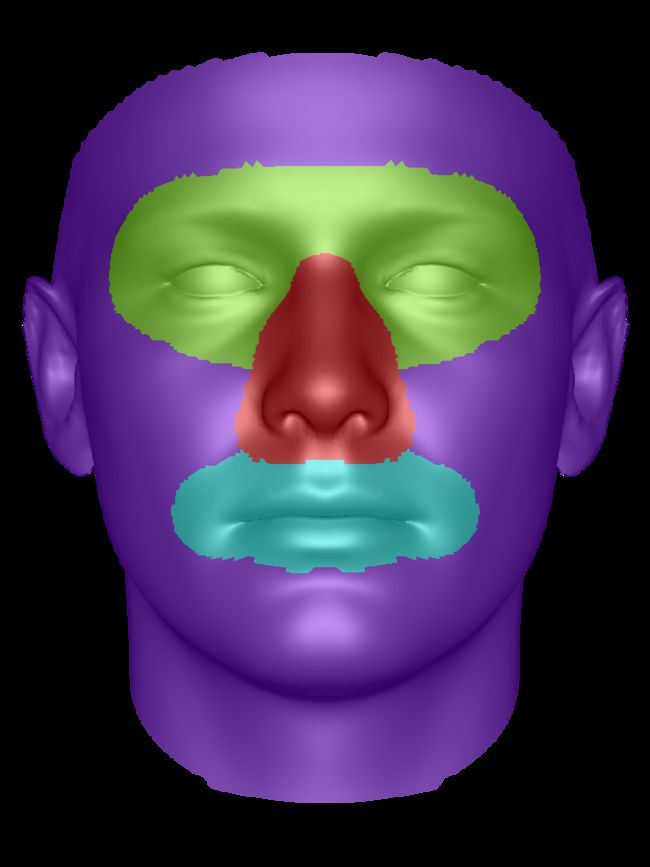3DMM模型
目录
-
- BFM
-
- BFM_2009
-
- 01_MorphableModel.mat
- exp_pca.bin
- topology_info.npy
- exp_info.npy
BFM
BFM_2009
01_MorphableModel.mat
from scipy.io import loadmat
original_BFM = loadmat("01_MorphableModel.mat")
# dict_keys: ['__header__', '__version__', '__globals__',
# 'tl',
# 'shapeMU', 'shapePC', 'shapeEV',
# 'texMU', 'texPC', 'texEV',
# 'segbin', 'segMM', 'segMB']
这个mat文件是通过MATLAB创建的,所有的index都是从1开始,需要特别注意。这个文件里主要存了3DMM mesh的几何(shape)和纹理(tex)相关的PCA参数。
__header__ \text{\_\_header\_\_} __header__: MATLAB 5.0 MAT-file, Platform: GLNX86, Created on: Wed Jul 23 15:09:28 2008
__version__ \text{\_\_version\_\_} __version__: 1.0
__globals__ \text{\_\_globals\_\_} __globals__: []
tl \text{tl} tl: [106466, 3],106466个面片,每个面片的顶点序号。
shapeMU \text{shapeMU} shapeMU:这个字段存的是mean shape。维度 [160470, 1], 53490个3D顶点reshape成了[160470, 1]的维度,数值范围[-114062.2, 131943.88],实际使用时,一般会除以1e5,将单位统一到分米。
shapePC \text{shapePC} shapePC: 这个字段存的是 principle shape components,shape的主成分基。维度[160470, 199],基的维度为199维。数值范围[-0.041886166,0.046161193]。
shapeEV \text{shapeEV} shapeEV: 这个字段存的是shape eigen value,表征shape每个主成分分量的标准差。维度[199, 1], 数值范围[3750.5396, 884336.25]。
texMU \text{texMU} texMU: mean texture,维度[160470, 1],数值范围[14.414997, 239.3551]。
texPC \text{texPC} texPC: principle texture components,维度[160470, 199],数值范围[-0.050797794, 0.055871148]。
texEV \text{texEV} texEV: texture eigen value,维度[199, 1],数值范围[127.32297, 4103.179]。
segbin \text{segbin} segbin:维度[53490, 4],以one-hot的形式定义了每个3D点所属的语义类别,如下图所示总计分为4类。
segMM \text{segMM} segMM: 维度[53490, 53490],稀疏矩阵。
segMB \text{segMB} segMB: 维度[53490, 213960],稀疏矩阵。
shape或者texture的计算公式为:
obj = mu + pc * (coef * ev)
shape还会叠加上表情系数带来的顶点偏移量。因此更具化的计算过程如下:
texture = tex_mu + tex_pc * (tex_coef * tex_ev)
shape = shape_mu + shape_pc * (tex_coef * shape_ev) + exp_pc * (exp_coef * exp_ev)
shape /= 1e5
原生的BFM2009只有shape和texture,没有提供表情相关的PCA参数。表情相关的PCA参数用的是下述的exp_pca.bin。

exp_pca.bin
原始的BFM2009模型包含53490个顶点。
CNN-based Real-time Dense Face Reconstruction with Inverse-rendered Photo-realistic Face Images中提供的表情基包含了53215个顶点。真的是说来话长,这里的53215个顶点是借鉴了Face Alignment Across Large Poses: A 3D Solution这篇论文的处理方式,删掉了inner mouth vertices,具体从原始的53490个顶点中取了哪53215个点构成新的mesh,可以看model_info[‘trimIndex’]字段。那又为什么要删掉口腔内部顶点呢?
D3DFaceRecon又在53215的基础上沿着face landmarks裁剪,新的mesh包含35709个顶点。
topology_info.npy
topology = np.load("topology_info.npy", allow_pickle=True).item()
# dict_keys: ['tris', 'vert_tris', 'sub_inds']
这个npy文件定义了顶点数为34650,面片数为68746的 mesh \text{mesh} mesh拓扑结构。
tris \text{tris} tris: [68746, 3],每个面片由3个顶点组成,这个字段存储了68746个面片的每个面片的顶点序号。
vert_tris \text{vert\_tris} vert_tris: [34650, 8], 每个顶点会连接8个三角面片,这字段存储了34650个顶点的每个顶点连接的面片序号,面片从0开始编号。
sub_inds \text{sub\_inds} sub_inds: [34650,], 顶点序号从0开始,排到了53423,但实际只使用了34650个顶点,这个字段存储了这34650个顶点的序号。
这里有个问题, sub_inds \text{sub\_inds} sub_inds最大序号是53423,合计53424个点,01_MorphableModel中定义的mesh是53490个点。少掉的具体是哪66个点?
exp_info.npy
exp_info = np.load("exp_info.npy", allow_pickle=True).item()
# dict_keys: ['mu_exp', 'base_exp', 'sig_exp']
mu_exp \text{mu\_exp} mu_exp:表情均值,维度[103950,],34650个3D点reshape成了[103950,]维度,数值范围[-607.75006, 725.0776]。
base_exp \text{base\_exp} base_exp:表情基,维度[79, 103950], 表情基维度为79维,数值范围[-0.028425552, 0.07618008]。
sig_exp \text{sig\_exp} sig_exp:表情基的方差,维度[79,],数值范围[1587.7286, 285403.94]。